Welcome to The Complete How To Guide for Business Strategy as a Mid-Tier Organisation with 35-120 Staff.
Creating a Strategic Planning ‘System’ at your size business is different to smaller (2-12 or 12-35 staff) or larger (120+ people) businesses. In this Guide:
- Learn how to do it yourself
- Download our guides and templates
- Upskill with short, specific videos
- Make your business planning or strategy day a success, AND
- (Most importantly) Turn Strategic decisions into implemented actions to grow your Capability Phase Business
OOPS! I have 2-12 Staff | I have 12-35 Staff | I have 120-500 Staff
Quick Index
- About the Author
- Why 35-120 Staff is a Special Category
- What is Business Strategy?
- Why do you need a Business Strategy ‘System’?
- The 7 Elements of a Business Strategy System in a Capability Phase Business with 35-120 Staff
1. A Documented Vision – Commercial, Cultural, Personal
2. Annual Strategy Day – How to run an Annual Strategy Day, including Agendas, and a detailed guide on who to invite, where to host, and how to follow-up
3. Strategic Capacity Plan Documented – Including 3 simple Business Plan Templates for you to choose from
4. Monthly Board Meeting – Including Agendas and Invitation list
5. Monthly Strategy Session – Including Agendas and Invitation list
6. Weekly Financial Scorecard – How to build one and what to include
7. Priorities Dashboard – How to build one and how to implement for maximum success - How can Jacob Aldridge Help
- In Conclusion / Comments and Questions
About the Author
I’m Jacob Aldridge, the only Deep Generalist, Portfolio Entrepreneur, International Business Advisor with a Guinness World Record in his office.
Since 2006, I have helped design, develop, and implement business strategy for more than 300 businesses around the world – and I’ve run workshops and seminars on the subject for thousands more business owners looking for a “How To Guide to Business Strategy” that they can implement themselves.
You can fast-track the process and invest in my services, but first I’m going to give you enough information to do it all yourself.
My intent as an advisor and business owner myself is to
- Communicate clearly how you and your team can absolutely implement a systemised approach to great business strategy without investing in business coaches or advisors, while
- Demonstrating so much value that fast-growth business owners will see the investment opportunity anyway.
So if I miss anything – if I leave you with any questions – leave a comment or send me an email and I will update this Guide accordingly.
Why 35-120 Staff Members is a Special Category
You are in the Capability Phase of business growth. Have you ever wondered why some businesses grow at an accelerated pace, while others seem to get stuck in a quagmire for years?
The answer – in part – is the transition points between ‘The 5 Phases of Business Growth’. You can learn about all 5 Phases (the Process Phase is Number 2) in the 5 minute video below.
The Capability Phase starts around 35 staff (including yourself).
New small businesses usually start in the Doing Phase, where the business owner/s are responsible for doing everything important themselves – Marketing, Sales, Finance, HR, and so on. At around 12 people a business becomes too big for that to function, and it shifts into the Process Phase – the business owner/s must stop doing and start overseeing processes not tasks.
But at that size, the owner is still restricted by their own experience and capability – they are too small to hire full-time specific strategic capability in key functions.
This starts to change at around 35 people – you now have the opportunity, and often the necessity, to add those additional strategically capable roles. You may still be the person who best knows the business, and how everything fits together – but you can confidently defer decisions to more capable experts at last!
The Capability Phase lasts until around 120 people – at that point, strategic capability will shift from key individuals to teams who develop their own Strategy as part of the overall organisation.
But for now, and for your Business Strategy planning, being in the Capability Phase means using the wisdom you have recruited to advance your business plans – while herding all those cats to keep them moving in the direction you choose.
This Guide to Business Strategy will outline how to use your team in a systemised approach to business strategy, while still ensuring you have ultimate control and direction.
What is Business Strategy?
Why do I need a Business Strategy System?
If you are already convinced that you and your business need a better approach to strategic planning, then you could skip this section.
In my experience, however, most small and medium sized business owners are confused about what business strategy is – and is not – and are therefore not confident to design a system or implement strategic planning with their team.
So before we jump into “How to create business strategy”, let’s answer the question “What is Business Strategy?”
What business strategy is not
It helps to begin by discussing what business strategy is not, to dispel some of the more confusing myths. Business strategy is NOT:
- Setting your Vision (though that will guide your strategy);
- Agreeing on your Mission, Purpose and Values (though again, doing this exercise first will help you design better business strategy);
- Doing a SWOT analysis. I’ve ranted about SWOT enough, but essentially understanding your business today is not the same as planning for its future;
- Documenting how you do what you do (invaluable as clear processes and procedures are);
- Golfing all day until you come up with a new plan for the company

Because it’s such a broad word, Strategy gets pulled into a whole lot of different activities. As a result, many businesses feel they know what business strategy is in general – and also how to artfully create business strategy for their business.
Only to have that confidence fall apart when I (or a team member) start asking them some simple strategic questions.
And I’m guilty of this confusion myself. When a business advisory client wants to improve their Culture or Brand, I will encourage them to develop a Culture Strategy or Brand Strategy – a brief document that explains what decisions they are making on that topic, why they are making them, and who is responsible for executing those changes. While that’s useful for approaching a specific business topic, it doesn’t answer the overall question about what business strategy means.
So, what is it?
Here’s the simple answer:
A business strategy is a road map of ordered priorities that will take you from where you are now, to where you want to be in the future, with a full understanding of why you are in business and an underpinning of commercial reality.
– Jacob Aldridge
If you’re just looking for the one-sentence answer to your question, I hope that has satisfied your request.
If, however, you’re interested in understanding how to design and implement great strategy in your business, then it will probably help us to break down that definition.
At this point, if you’re already bored, why not just watch this Blackboard Fridays episode where I talk about Growth Planning (aka Strategy) using the concept of the capacity engine to help power your planning.
Then you can either break down that definition further, or skip to the next section.
from where you are now
You’re planning a road trip, only instead of a trip from Coolangatta to Cape York your trip will take you and your business from NOW to WHERE you want to be.
It’s critical, then, to understand where your business is today. I recommend discussing this with your business partners and leadership team across three areas:
- Commercially (including Revenue, Profit, Business Valuation, and any other key financial indicators you use);
- Culturally (from a general idea of how the business feels all the way up to your Culture Paper); and
- Personally (how is the business supporting you and the other business owners).
“NOW” is your starting point. It may not be pretty, and (especially if it’s not pretty) you want to record and remember this starting point.
Because in 18 months, when the first of your big strategic steps have been fully implemented and that change has become ‘business as usual’, you will forget the pain points you are currently experiencing.
Indeed, one thing that kills many great business strategies is forgetting that pain within 3-6 months. Instead of developing an improved system that ensures those concerns never return, you and your business settle for a quick fix. Real change never takes place, and sure enough, you’ll be back in that pain sooner rather than later.
Writing this down and holding yourselves accountable to changing those feelings and financials is an important step.
to where you want to be in the future
Once you have a clear idea of the business now, commercially, culturally, and personally … where do you want to take it?
Ideally, you can match up all those key elements. If NOW your current turnover is $9 million, valuation is $5 million, you’re feeling frustrated, and you’re only taking home $250,000…
… then your WHERE vision may be $24 million in turnover, with a valuation of $15 million, feeling relaxed, and paying you $750,000.
Completing a full Vision exercise with your business partners isn’t absolutely necessary at this step, but will ensure you are all aligned to the direction and destination of the business, especially if you engage an external facilitator or coach to manage the session so you can all participate as equals. You do NOT want to discover halfway through implementing your strategic road map that one of your business partners wants to sell at $10 million and will derail everything if he doesn’t get his way.
It may also be that you want a business strategy that only takes you part-way to your much larger vision. My biggest piece of advice is to define that WHERE clearly, and make sure it’s still exciting to you and the team, and then build the strategy to get you there … rather than picking an arbitrary time frame like ‘a five-year plan’.
Focus on the destination and the strategic steps and you’ll grow faster; connecting them with an ad hoc time frame makes your strategy subject to clock-watching!
with a full understanding of why you are in business
Back to the road trip analogy, and while it’s imperative to know where you are driving to … it’s even more critical that you and your passengers are agreed about WHY you’re making this trip.
Maybe you’re going to Cape York for a full moon festival and you need to be there as fast as possible. Maybe this is a once-in-a-lifetime opportunity to experience the beautiful Queensland coastline.
Both of those are excellent reasons for a trip. Neither is better or worse, more right or more wrong, than the other. But imagine if half the passengers in your car want to drive through the night as fast as possible … and the other half want to stop for a swim at every beach along the way. How far into the trip before you’re all ready to kill each other? Bundaberg? Maryborough? Will you even make it past Surfers Paradise on the Gold Coast?
In business, there are a number of key WHYs – I call them the layers of context. And in this context – influencing your business strategy – the two key questions are related to:
- your business purpose (sometimes called your mission or intent; WHY you are in business from an internal perspective) and
- brand (WHY you are in business from an external perspective).
My business exists “To be the Catalyst for Others“. This isn’t lip-service marketing guff; it’s a decision-making filter I use when determining strategy – specifically, it forces me to make choices that connect and benefit the most number of people.
Given the choice between two options, or when my Board is stuck or confused about the best course of action, I ask myself ‘Will this connect with others so we can be a catalyst for their change?’ If the answer is no, I need a rethink.
So that’s what I mean by defining what business strategy is, by having a full understanding of why you are in business. Because if your strategy does not reflect your purpose and brand, it is doomed to fail. You’re destined to devolve into a McDonald’s carpark screaming match arguing about which road-tripping tunes to play next when all you needed to do was agree to upfront on why you were making this trip in the first place.
a road map of ordered priorities
I know this one is out of order, but it’s impossible to define your road map without making sure we’re clear about NOW, WHERE, and WHY you’re on this journey.
By now, it’s probably obvious what I mean by a road map of ordered priorities. Ultimately, this is your business strategy – a list of key steps you need to take, in a specific order.
At the risk of belabouring my Queensland road trip metaphor, you know you need to see Brisbane, the Sunshine Coast, Townsville and Cairns as part of your journey, and it’s pretty obvious that there’s an optimal order in which to visit them. The same is true, though less obviously, with your business strategy.
Take one of my blue-collar clients who were screaming for more tradespeople to help their business grow. They knew that to sell their business for the best valuation – their reason behind completing a business strategy – they needed to have a strong Brand and Culture. But they saw this as something they would do ‘down the track’ once they had the right size team on board and were more profitable.
They didn’t realise that part of their failure to grow that team was due to a lack of strong Brand and Culture. They had the right steps on their road map, but they had them in the wrong order and it was holding them back.
As a result of working with me, they built a new website and featured a recruitment page with their current team discussing key elements of their culture – they added 6 new technicians (50% growth) in less than a year.
So a business strategy needs to include all the necessary steps to take you from today to your vision (or whatever destination you define). Even more importantly, it needs to order those steps in the best way.
And this is one reason why many forms of business coaching don’t work for Capability Phase businesses. Pure coaching is about asking the right questions and assuming the business owner has all the answers. By the time you have become a Capability Phase business, you already know that you don’t have all the answers! You need the support of someone who can also bring strategic business advice and tell you when your (or your key team members’) plans are missing steps or are out of order.
One more thing about a road map – changing the order has significant flow-on effects that need to be considered. If you’re halfway to Cape York and someone tells you how beautiful Melbourne is to visit (and it is … to visit) would you rearrange your map to go via Melbourne? Of course not, yet that’s just the kind of distraction entrepreneurs are famous for, setting out the key steps of their long term vision, and then three months later chucking in a new website and social media plan because they saw a cool presenter at a seminar.
an underpinning of commercial reality
Since we’re asking, ‘What is business strategy’, it’s necessary to acknowledge the requirement of commercial reality. It doesn’t matter how altruistic your mission or personal desire: whether you’re an investment bank, not for profit, or social enterprise, the dollars need to make sense.
When I was a journalist (I also worked in a video store – want a dying business model, ask me how!) we used to talk about Janus the two-faced Roman god because of these dual necessities. Journalists had an obligation to public service, but we couldn’t be ignorant of commercial demands because if our publication didn’t make money then we couldn’t operate and we wouldn’t be able to serve the public anyway.
So when I’m talking about the commercial reality of good business strategy, I set aside my care for whether you’re in business to make millions or change the world (or both). I just want to make sure that your journey from NOW to WHERE doesn’t fail for lack of financial consideration.
Lack of financial systems is one of the reasons why great business ideas fail. The framework I use and recommend for Growth Planning involves building a capacity model of your business engine – giving you an objective view of how much power (revenue) your business engine can produce and which levers you can pull to change the revenue and profit outcomes.
With this model – however rough and ready you may build it – you can stress test the milestones on your strategic road map. Launching that new product in two years? How much investment – RND, Marketing, Recruitment etc – will you need to make in advance of selling the first unit? Have you got enough free cash flow to fund that investment?
And honestly, most businesses have a pretty simple model largely dependent on people and time. While I recommend creating new products that help you escape that business model, and have a lot of fun with my clients doing just that, chances are you can achieve your vision in the next few years simply by understanding your business financials and replicating the key elements a few more times.
So again, what is business strategy?
A business strategy is a road map of ordered priorities that will take you from where you are now, to where you want to be in the future, with a full understanding of why you are in business and an underpinning of commercial reality.
– Jacob Aldridge
It’s agreeing to the key steps your business needs to take to achieve your vision, powered from above and below by your motivation to be in a business and a financial position that energises your bright ideas.
On the one hand, it’s a simple set of ingredients. And if you’re in business, then you already have most of that in place – whether it’s conscious, documented, and shared with your team or not.
Building a Systemised approach to your Business Strategy – so it’s updated and implemented every month, every quarter and every year – is the next step in your business success.
Why do you need a Business Strategy “System”?
For most business owners, Strategy is a reactive and occasional concept. You have successfully grown beyond this limiting mindset, but in recruiting highly capable individuals you may encounter another challenge – keeping them aligned and focused on your vision and strategy, not pursuing their own agendas or fighting between themselves for resources or glory.
The only way to simplify strategy – to reduce the time and money investment you make each year – is to build a system that your whole business can follow with ease.
Most business advisors won’t help you do this of course – they get paid when you bring them back every month / quarter / year, so they need you to remain a little helpless.
Remember – this Complete How To Guide to Business Strategy is here to help you do it all yourself.
The 7 Elements of a Business Strategy System in a Capability Phase Business with 35-120 Staff
Here are the 7 Elements of a Business Strategy System for a Process Phase business.
- A Documented Vision – Commercial, Cultural, Personal
- Annual Strategy Day
- Strategic Capacity Plan Documented
- Monthly Board Meeting
- Monthly Strategy Session
- Weekly Financial Scorecard
- Priorities Dashboard
1. Your Documented Vision
If your Vision is in your head, then it isn’t real.
The very act of documenting your Vision (and, as we will see later, your strategic business plan) is immensely valuable, because being forced to communicate it will often reveal blindspots in your thinking process.
For active growth businesses, I recommend involving at least the leadership team in (parts of) your Vision exercise. The only exception would be when you have 3 or more partners or directors already involved, and in that case be careful to avoid a different problem – the person running the exercise could either force their choices down everyone’s throats (from the front of the room) or be ignored (while they manage the energy of the discussion).
There are 3 parts of every Business Vision: Commercial, Cultural, and Personal Vision. If you need some guidance to each of those steps, enjoy these 3 Videos!
While you don’t need to share your Personal Vision in all its detail with the Team, they will be crucial to achieving your Commercial and Culture Vision and as such need to be aware of them – or even involved in their creation and documentation.
The next section includes a guide to working with your Team to create these.
Just remember though: Business is not a Democracy! Vision is not about you as the business owner/s asking “Where are we going?”. Vision is about you as a leader saying “Here’s where I’m going – Who’s coming with me?”
2. Your Annual Strategy Day
If you’ve been in business for more than five minutes, I can guarantee you’ve had a terrible strategy day experience – all talk, no action, and the highlight of the day was the mediocre muffins at morning tea.
You deserve better. Your team and your customers deserve a business that knows where it’s going, and why, and most importantly how it’s going to get there.
You need to run a great strategy day. An amazing strategy day. The kind of strategy day that your team will talk about with reverence for years to come – “Do you remember the Post-Pandemic session we had in 2020? Now THAT was a good day.”
And for a Capability Phase business, I would encourage you to consider making that “day” something more akin to a two-day offsite strategic retreat. This can be combined with some team or cultural activities if you desire, and becomes a great addition to your annual calendar.
Here are the six steps to making an amazing strategy “day” happen.
1. Agree the Strategy Day Purpose
Not all strategy days – also commonly referred to as team offsites, strategic retreats, or (though I shudder at the term) team building days – are created equal. There are a number of different outcomes you may be seeking, so you need to be clear about your specific purpose before the day so everyone comes ready to focus appropriately.
The most common strategy day purposes I see are:
- Vent – My buddy John Knight calls this The Good, The Bad, and the Ugly. It’s not about solving the world’s problems, it’s about identifying what’s really going on in your business and openly airing any concerns so a way forward can be found that doesn’t sweep them under the carpet.
- Brainstorm – You have some general thoughts and questions, but not yet any solutions. Open up to input from the partners or team to uncover all your options and opportunities.
- Discussion – You have some specific ideas, and are looking for a focused discussion about what they would look like in practice in your business.
- Present – Either presenting recommendations or board decisions, this may include some discussion but most of the strategic thinking has already been done by a project team or business leader. Make sure said team or leader is ready to present!
- Decide – Often linked to the Presentation, this asks the partnership or leadership team to make key decisions. No more sitting on the fence – are we going to do this or not?
- Team Building – If you only want a team building day, do it well and don’t let strategy get in the way. But just so you know – if your culture is in dire straits and your team members hate coming in to work each day, even the best team building session is only putting lipstick on a pig.
Especially if you have a full day (or a two-day retreat), you may want to set a different purpose for different sessions. For example, you may start by Presenting some recommendations; then opening up a Brainstorming session; then bringing it all together to make some key strategic Decisions; then hitting the golf course or Aquaduck for the team building component.
Just communicate the shift, and don’t blur the purpose. You do NOT want to be deciding strategy on the Aquaduck.
Capability Phase businesses (see point 4 below) have more ‘Present’ and ‘Decide’ sessions than the ‘Vent’ and ‘Brainstorm’ of a smaller company.
2. Decide who to Invite
Having the right people in the room for the conversations you want to have is critical, and again you may split the day – for example, Directors / Leadership team in the morning, and a wider group in the afternoon.
If you have multiple shareholders, I would encourage you as a group (possibly with your GM / Operations Manager if applicable) to be running some kind of strategy session as a small group probably each month (see the next heading). Honestly, I find the most valuable strategy days are those where the directors give themselves the luxury of a whole day or two out of the office without the rest of the team around. There will be plenty of time to communicate with them later – this is your opportunity to lead and go deep into the parts of the business that really energise you.
If you do choose to include your team, a maximum group size of 12-15 is optimal for running a great strategy day. In my experience, willingness to contribute to a discussion tapers off dramatically once you have a group of 16 or more people.
If you feel obliged to include more people than that, or indeed invite the whole team, then you need to create two separate (but related) events. Keep the Annual Strategy Day / Retreat as tight as I recommend; create a separate, larger event where the recommendations of the Strategy Day can be discussed, understood, and accepted by the larger group. And make sure those plans involve plenty of small group / table activities to encourage contribution, but seek to involve everyone.
For the maximum 12-15 people you may want to invite a cross-section of the different departments, in order to prevent the ‘Us versus Them’ mentality that is sometimes created between Sales / Technical / Admin / Management teams. Look for people who:
- Have experience and perspective about both their functional area and the overall business;
- Are outspoken, so will be willing to contribute on the day and represent their absent colleagues strongly;
- Fit your business culture, so they don’t push strategic decisions in a direction that doesn’t align with your overall purpose.
Remember, this isn’t a democracy – you don’t have to justify your choices about who is and isn’t invited.
If you want team members to prepare anything (see point 4 below) including having discussions with their colleagues who won’t be present on that day to see if there are any issues or opportunities worth discussing, be sure to give them plenty of notice.
3. Have an Agenda
A great coaching technique is to start each session by asking the client what’s on their mind. This is a TERRIBLE approach to running a great strategy day!
You need to plan ahead, and distribute the agenda to every attendee at least a week in advance. This is partly to help them prepare, but more importantly it demonstrates that the strategy day has been planned and that you are organised. This gives your attendees increased confidence in the value of the day – it’s not just something that’s been slapped together and will be very quickly forgotten.
If you do run monthly, quarterly, or annual business strategy days – as many of my clients do – you may develop a regular agenda that keeps them consistent. It’s still a useful exercise to circulate this a week or two beforehand.
If you have never run a strategy day before, you may be looking for a business strategy day template agenda. And you’re in luck: here is the best and simplest strategy day agenda (including times!).
Navigating the Year Strategy Day Agenda
(i) Welcome. 5-10% of your day
- Confirm the Agenda and Expectations for the Day
- Create a ‘Brainstorm’ Board for capturing ideas
- Agree Documentation and Actions process
(ii) Vision. 10-30% of your day
- Review the Commercial Vision for our business – Income and Equity
- If you don’t have a documented Vision, give yourself more time here to create it using the strategic frameworks in my vision videos above
- What are our Annual and Quarterly Targets?
(iii) Strategy. 20-30% of your day
- Review Growth Planning – use the Capacity Engine to agree Strategic Priorities for the coming year (and beyond)
- Review Income Matrix – What Product and Channel mix will reach our targets?
- Review Sales Hourglass Management – Are we generating enough activity, and converting successfully, to reach our targets?
(iv) Resources. 20-30% of your day
- Operational Structure – What needs to change in regards to Skills, Responsibilities, Technology, Premises, Suppliers etc?
- Training Needs Analysis – if required
(v) Execution. 5-10% of your day
- Agree Strategic Priorities and Roadmap
- Confirm the clear decisions and actions agreed to ensure you execute on your strategic plan
These are starting points. Just as I walk through this template strategy day agenda with my clients to personalise it, so too you may want to add or remove certain sections that are less relevant for your business today.
You will need to add times to the sessions, and be sure to include sufficient breaks throughout.
If some of those sections look confusing or like jargon, you might enjoy this overview of “The Most Colourful Business Strategy in the World” – to help demonstrate how my business methodology integrates all the different aspects of your company to make strategy simpler.
4. Come Prepared
This step is one of the fundamental differences between your Capability Phase business and smaller Doing or Process Phase organisations. Few key strategic decisions can be brainstormed and discussed afresh at your Annual Strategy Day – instead, this is the forum to interrogate recommendations Presented by your key people and to make specific Decisions.
This becomes easier from Year Two, when you have a documented Capacity Growth Plan to help guide you. It’s OK if the first time you run this Day it’s clunky – you can even set that expectation with your team.
Take some common strategic choices or priorities for a business of your size: New Products post-Recession, Expanding into new Markets, Creating a New Website, or Increasing Valuation Multiples.
Can any of these be properly research, planned, and agreed in 1 or 2 days? Of course not. Historically, that may not have been a problem because you as the business owner, or each of you as partners, would have been contemplating these opportunities / challenges and almost by default come prepared.
Now you have key strategic resources in some of those functions. Use them! Their role is to come to the Annual Strategy Day prepared with recommendations they can present, defend, or at the very least discuss in an open manner.
In some cases, the individual represents their wider team, of employees or suppliers. If a new website is on the agenda, for example, I would expect my Marketing Manager to have discussed thoughts with their team, with current or proposed suppliers, and to come prepared to discuss the most relevant aspects of the project like Brand or Budget.
Pre-reading may also form part of your Strategy Day. Anyone who is Presenting could be expected to provide a business case for their recommendations, and/or a list of open questions they want to discuss or decide. Distributing this document in advance will multiply the value of your Strategy Day many times.
5. Assign Key Roles
There are two key roles that are imperative for any successful business strategy day – the Documenter and the Facilitator.
The Documenter’s role is to take notes. Agree with them in advance whether these are detailed, formal minutes or (my personal preference outside of a Compliance Board environment) focused just on a specific list of agreements and actions. Having a laptop or tablet they can type directly into will save time afterwards. And make sure you communicate with this person whether you want them to contribute in the discussion or not.
The Documenter is also responsible for distributing these notes afterwards – perhaps to the business owner or CEO for review first, and then to all attendees or the whole business in a timely manner.
The Facilitator’s role is to manage the energy of the group during the day, which includes obvious elements like sticking to the agenda and timing, as well as more nuanced leadership skills like ensuring everyone’s voice is heard and identifying when a breakthrough is imminent and guiding the team in that direction.
Is it worth paying a business coach or facilitator to run your strategy day? This depends on the experience of you as a business owner, and also the purpose of the day (an experienced facilitator will help with making key decisions, for example, and will often be able to bring their own frameworks to accelerate the discussion for a better outcome).
Don’t be afraid to invest in this role. As a business owner, you need to be part of the discussion and decision-making at your strategy day. And that’s difficult to do when you’re managing the energy of every participant from the front of the room. Expert facilitators may cost you anything from $1,500 to $5,000 per day – if you’re making decisions about strategy for a multi-million dollar business, that’s a very small price to pay to make sure it’s done well and you don’t have to repeat this exercise again in a short while.
6. Agree Location
Sometimes it’s necessary to take the team away from your office in order to maximise the benefit of your strategy day – they will be better able to think ‘big picture’ if they’re not surrounded by everyday décor, and they’re not running back to their desks to check emails and make phone calls at every break.
If you do hire an external room for the day, make sure it has plenty of natural light and a reasonably high ceiling. Both have been proven to improve strategy day outcomes.
This can be as fancy, or not, as you choose. My team has run strategy days for clients on the beachfront of Moreton Island … and in the meeting rooms above some dodgy pubs!
If parking at the location is going to be difficult, be sure to communicate this with the team beforehand and possibly arrange some carpooling from the office with plenty of time to grab a coffee at the venue and start the day.
Oh, and on the topic of coffee … I’m not the only one who loves a caffeine jolt to kick off a great strategy day, so check with the venue that this is available. There are some awesome meeting venues, like the Brisbane Powerhouse, that don’t have coffee available nearby until later in the day … not a good start for those who need (or prefer, or just have the expectation of) a morning fix.
7. What Happens Next
Lastly, you need to remember that a great strategy day is part of an ongoing business system, and it doesn’t stop when you and the team call it a day.
Immediately afterwards, you may choose to organise some drinks or a team dinner. These can be a practical way for the team to unwind from a purposeful day. If you want the conversation to continue – or plan a working dinner mid-way through a two day strategic offsite – be sure to communicate that so expectations are clear.
Within two weeks, the Documenter needs to circulate the agreements and actions from the strategy day. If these already have timeframes and responsibilities assigned, then your business can move forward with those actions.
If not – and in my experience, they usually won’t – then within 2-4 weeks of the strategy day you need to schedule a follow-up meeting in your office. I actually recommend scheduling this before the actual strategy day – again, to demonstrate to the team how organised and committed to this process you are.
At this meeting you want to shift the strategic decisions into implementation mode.
- What are the key steps?
- Who is responsible for each one? (Only one person can take responsibility, though they may have several team members helping them to make it happen)
- When do you expect that step to be completed?
By having this follow-up meeting in your office, you have demonstrated that the offsite strategy day has been brought back into the day-to-day operations of your business. It’s an important emotional step in ensuring strategy turns to implementation.
This document becomes the ‘To Do List’ for the next Monthly Board Meeting and Monthly Strategy Session – an important tool that will become clearer further down.
Ultimately, it is that implementation that determines whether you had a great strategy day … or not.
3. Strategic Capacity Plan Documented
One of the most common requests I receive is from business owners or managers wanting a ‘Free Business Plan Template’. I’m always happy to help – and I usually find that what they want is not actually going to help with why they want it.
What does strategy mean to you?
Obviously a Template is only going to help if it meets your needs – and in my experience working with hundreds of businesses, entrepreneurs can often have very different definitions for ‘strategy’ and ‘business plan’.
We know from above that good business strategy sets out what exactly you as a business are going to do, from one step to the next, in order to move from where you are now to where you want to be in the future. Moreover, it needs to bridge the gap between Inspiration and Execution.
However, I’ve spoken with people who approach strategy in different ways. Many entrepreneurs are inspiration-junkies – they love to jump from one bright shiny idea to another, without spending the time to plan or execute any of them! They don’t want a business strategy template loaded with detail – they just want the headlines. I have to explain to them that headlines and shiny ideas don’t grow businesses.
On the other side are people looking for loads of detail – what I would call an Implementation Plan. More than just explaining “What needs doing, and Why”, these people (often business managers or those with large corporate backgrounds) are looking for a strategy template full of “How” questions – how are we going to execute this fully. I applaud their commitment to fully realising the benefits of good business strategy; but for now, we need to take a step back. A great strategy paper doesn’t overwhelm the audience with detail – and doing so can sometimes kill that implementation plan before you even get to start it.
What Topic do you want Strategy for?
The next question I ask is whether there is a specific topic for which you want a business strategy template. This is because beyond the high level questions – Why are we doing this? What are the steps? How are we implementing? Who will do this by When? – no two business topics are the same.
There is no such thing as a generic strategy template that covers topics as wide-ranging as Culture, Valuation, Training, and Supplier Management. Each of those demands of the business a specific skill-set – in fact, they’re so varied they come from 4 separate colours in the business spectrum.
Often when people are looking for a business strategy template they are looking for a general growth plan for their organisation. But if I walked through the growth plan process, and you wanted a strategy template for designing an awesome workplace culture, then you would think I was wasting your time.
For a Capability Phase business, you may want the best of both worlds – absolutely one of the simple, whole-of-business strategy plans templated below, and also a strategic plan for each core function driven by the responsible person and which clearly connects to the overall business strategy.
Who else is involved?
The third and final question, once we have determined that you are looking for a general growth plan strategy template: who is involved in creating this strategy?
You’re not looking for a business strategy template in the form of a word processing document you can fill in and pass on. You want a strategy template designed to engage your team and partners, and make sure you’re asking all the right questions to design the best strategic plan.
So the simplest Business Plan Template covers the specific elements in the ‘Navigate the Year’ agenda above:
- Commercial and Cultural Vision (in full, or refresher)
- Annual and Quarterly Targets
- Capacity Growth Plan
- Income Matrix
- Sales Hourglass Targets
- Resource Changes
- Training Plan
- Action Plan – who will do what by when
For many business owners, planning the year ahead is the appropriate amount of time – it bridges the gap between the long-term vision and short-term cash flow demands.
In practice, the strategic roadmap you can create through this process need not be limited to any timeframe. You may discover that with this focus you achieve incredible things in the next 90 days; similarly, the way forward over several years may become clear to you.
Don’t let annual strategy be a limiting belief, but rather a simple milestone on your journey.
Why aren’t there bigger sections? / How long should a strategy template be?
Maybe it’s the high school or MBA mentality that’s taught us ‘longer is better’, but when it comes to business strategy there’s only one way to define the right length … and that’s whatever length is right for you and your business.
As I told the Sydney Morning Herald when interviewed about the topic of business plans, “The greatest business plan, kept in the bottom drawer, is useless in business. Bullet points on the back of a beer coaster, which are implemented, can be worth millions.”
Based on the key questions provided in that template, you have the freedom to determine exactly the level of detail – and no more – that your team need to turn that business strategy into business reality.
Can you make our Business Plan shorter?
Absolutely! Two of my favourite ‘Business Plan’ / ‘Business Strategy’ templates are the Contextual Business Plan and just using the Capacity Roadmap.
Here is the whole one page Contextual Business Plan you can download end edit.

Here is an example of the Capacity Roadmap that you can replicate.
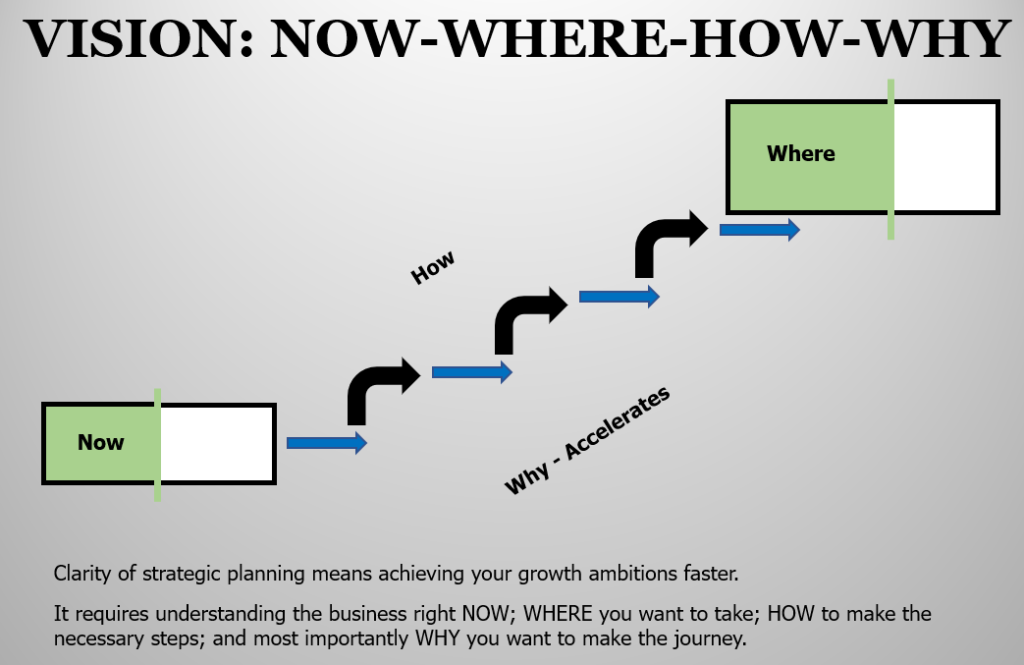
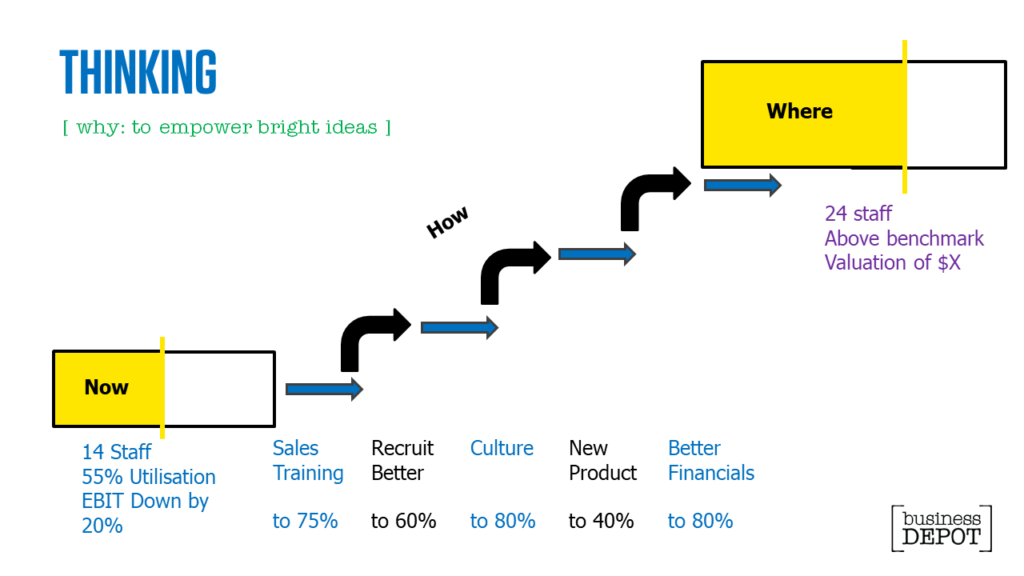
Sometimes – usually for the purposes of borrowing money or raising capital – you will need a long and detailed Business Plan. For a Capability Phase business, however, they are usually a waste of time – and can be detrimental to your business success unless you have the time or resources to make “Strategy” a full-time job.
Make Strategy part of everyone’s job. And that means keeping it simple – so people can understand, explain, contribute, and support your business strategy.
4. Monthly Board Meeting – Agenda
Once every Month, you need to be having a Board Meeting and a Strategy Session with your Leadership Team. The two have fundamentally different contexts, so resist the urge to combine them.
Each will run from 2 hours to a half day (longer if you want to add some cultural activities at the end). They don’t have to be on the same day, though within the same week is important and the same day is usually best.
Who do I invite to my Board Meeting?
[Compulsory]
- Chair (Can be one of the list below, or a separate invitee, but is a clear role. Some businesses rotate this role each quarter / year.)
- Note Taker (Can be one of the list below, and is also an agreed responsibility)
- Every Shareholder
- CEO
[Optional]
- Senior Team Members – eg, General Manager, Chief Operating Officer
- Business Advisor – either to facilitate or to contribute (be clear which)
- Advisory Board Members – Strategically-minded accountant, lawyer, mentor etc
What is the Agenda for a Capability Phase business Board Meeting?
(i) Check-in / Update. 5-10 minutes
(ii) Big Client Wins / Losses. 5-10 minutes
(iii) Weekly Financial Scorecard. 5-15 minutes
Note that at various milestones, and especially if you take external investment, the financial and compliance requirements of your Board may become more onerous than these strategic elements – and need more time as a result!
(iv) Priorities Dashboard Review. 5-15 minutes
(v) To Do List Review. 5-10 minutes
(vi) Issues and Opportunities. 90 minutes to 3 hours
This is the main Agenda for your Meeting and may be distributed in advance
(vii) Confirm Actions and Agreements. Final 10 minutes
Let’s walk through the specifics of each item.
(i) Check-in / Update. 5-10 minutes
How are you feeling right now? Have there been any major changes in your life since we last met?
This is a very quick whip around of everyone present. It’s designed to give context (eg, “I’m feeling overwhelmed right now and I have a sick child who may call”) not be a social occasion.
(ii) Big Client Wins / Losses. 5-10 minutes
Again – not here to talk about why or how Clients were won and lost – use the ‘Issues and Opportunities’ time to do that if necessary. Simply note any meaningful wins or losses so that everyone is aware.
(iii) Weekly Financial Scorecard. 5-15 minutes
Section 6 below explains how to design your Weekly Financial Scorecard. Your Scorecard, as well as your regular Monthly Financials, should be distributed and reviewed in advance by all attendees.
Even though this data is collected Weekly, in this meeting you are looking for trends across the Quarter. If the metrics on your Financial Scorecard are noisy (or concerning) then you may need to implement a Weekly Operations Meeting to monitor these more closely.
This section of your Board Meeting is only to review the financial data across those agreed key metrics. If something is unclear, ask a question, but if something needs analysing or managing then add it to the ‘Issues and Opportunities’ list.
Note that at various milestones, and especially if you take external investment, the financial and compliance requirements of your Board may become more onerous than these strategic elements – and need more time as a result.
(iv) Priorities Dashboard Review. 5-15 minutes
Section 7 below explains how to design and implement your Priorities Dashboard. At this point in the meeting you are merely reviewing each Priority and marking them as “Complete”, “On Track”, or “Off Track”.
You are NOT, under any circumstances, to waffle on about progress or wax lyrical with your excuses for not doing what you said you would do. If something needs to be discussed, add it to the ‘Issues and Opportunities’ list.
(v) To Do List Review. 5-10 minutes
Last Month you all made Agreements to do things. Now is the the time to review that list.
Notice the pattern. You are only to answer each To Do List item with “Done” or “Not Done”, and if necessary add things to the ‘Issues and Opportunities’ list. We’re all adults – no need for excuses or justification.
(vi) Issues and Opportunities. 90 minutes to 3 hours
This section forms the vast majority of your Board Meeting time. This is also where expert facilitation is crucial – choosing which items to address in which order, and when to wrap up a discussion or force a decision on each of them before moving on.
Your ‘Issues and Opportunities’ list is essentially the Agenda for the meeting, and can be filled in advance or through the earlier steps above.
Some items raised in the Board Meeting may be more relevant for review or discussion in the subsequent Strategy Session – in which case, move them to the ‘Issues and Opportunities’ list for that meeting (see below).
Not sure which items fit in which meeting? Review the 4 Colours of the RNR System here – Board Meetings are for Black (Wealth) and some Green (Growth); Strategy Sessions with the wider team are for some Green (where it forms part of their position description) and any Blue (Revenue) or Red (Admin) aspects of your strategy.
If you are Chairing your Board Meetings (or indeed, any team meetings) then you may like the Momentum Meeting Model I use:
You may also find some of the categories and choices in this video will help you to group and order your agenda items.
(vii) Confirm Actions and Agreements. Final 10 minutes
You may not get through everything on your Issues and Opportunities list, especially for the first year of running this system. And that’s OK. Roll them into next Month.
Never let your discussions result in skipping this final step. Always, with 10 minutes left in the meeting, stop whatever discussion is happening and switch to this final step – where the Note Taker or Chair confirms all of the Actions and Agreements that were made in the meeting.
These (with any “Not Done” items from earlier) are the “To Do List” for the next Board Meeting, and the final opportunity to re-litigate any decisions you may not have been happy with.
This list will also be distributed electronically within 48 hours of the meeting.
5. Monthly Strategy Session
Your Strategy Session will usually take place on the same day, or within a week, or the Board Meeting. It’s the connection point between Board-Level strategy and decisions, and the day-to-day Operations Management of your business.
Who do I invite to my Strategy Session?
[Compulsory]
- Chair (Can be one of the list below, or a separate invitee, but is a clear role. Some businesses rotate this role each quarter / year.)
- Note Taker (Can be one of the list below, and is also an agreed responsibility)
- All Active Shareholders
- CEO
- Senior Team Members – eg, General Manager, Chief Operating Officer
- Functional Heads / Managers
[Optional]
- Business Advisor – either to facilitate or to contribute (be clear which)
- Advisory Board Members – Strategically-minded accountant, lawyer, mentor etc
What is the Agenda for a Capability Phase business Strategy Session?
This is exactly the same structure as the Board Meeting. Keeping them aligned will mean you become faster at running these meetings – faster meetings with better decisions means more time for implementing strategy and growing your business!
(i) Check-in / Update. 5-10 minutes
How are you feeling right now? Have there been any major changes in your life since we last met?
This is a very quick whip around of everyone present. It’s designed to give context (eg, “I’m feeling overwhelmed right now and my mother died last week”) not be a social occasion.
(ii) Big Client Wins / Losses. 5-10 minutes
Again – not here to talk about why or how Clients were won and lost – use the ‘Issues and Opportunities’ time to do that if necessary. Noting the most important outcomes here is important.
(iii) Weekly Financial Scorecard. 5-15 minutes
Some elements of your Board Meeting Scorecard may be redacted from this discussion, though give your team credit and respect in regards to your financial transparency.
(iv) Priorities Dashboard Review. 5-15 minutes
At this point in the meeting you are merely reviewing each Priority and marking them as “Complete”, “On Track”, or “Off Track” – and adding to ‘Issues and Opportunities’ if necessary.
(v) To Do List Review. 5-10 minutes
Last Month you all made Agreements to do things. Now is the the time to review that list.
Answer each To Do List item with “Done” or “Not Done”, and if necessary add things to the ‘Issues and Opportunities’ list. We’re all adults – no need for excuses or justification.
(vi) Issues and Opportunities. 90 minutes to 3 hours
As with the Board Meeting, this section forms the vast majority of your Strategy Session time. Remember – you are making decisions to move the business along your Strategic Roadmap and towards your Vision. Those two contexts are the decision-making filters for every Strategy Session discussion or decision.
(vii) Confirm Actions and Agreements. Final 10 minutes
Never let your discussions result in skipping this final step. Always, with 10 minutes left in the meeting, stop whatever discussion is happening and switch to this final step – where the Note Taker or Chair confirms all of the Actions and Agreements that were made in the meeting.
These (with any “Not Done” items from earlier) are the “To Do List” for the next Strategy Session, and the final opportunity to re-litigate any decisions you may not have been happy with.
This list will also be distributed electronically within 48 hours of the meeting.
6. Weekly Financial Scorecard
As a Capability Phase business, your Weekly Financial Scorecard is a combination of common accounting measures (like Revenue) and more nuanced metrics that demonstrate the health or direction of your operations.
You definitely need some more advanced reporting than you will receive from your accountant. You also want to avoid the situation where every functional manager sends you loads of data every week/month – most of which is superfluous, and none of which is connected to other departments making you a bottle-neck for information.
Here’s what I do and recommend…
At either your Annual Strategy Day or the next subsequent Board and Strategy Meetings, you need to convert Strategic Priorities into measurable financial metrics.
As a simple example, if you want to increase Sales – then you need to track Sales Volume. Be sure to think laterally – you probably also need to track Sales Conversion Rates or Leads Generated. And make sure you don’t set yourself up for the wrong outcome – perhaps you also need to track Average Sales Value and Gross Profit Margin as well, to ensure you don’t end up with “more sales” but “the same revenue” and “less profit”.
Start with a long list, and then whittle it down to a manageable number. How many? This depends on how hard it is to access data in your business, and how many people you help helping you collate the report each week. If you need my rule, 3 per key function (Sales, Marketing, Finance and so on) is a good round number – if each key manager in your team can improve the 3 most important measurements in their function this year, that will have an incredible impact on your strategy and achieving your vision.
Chances are, the first time you create this Weekly Financial Scorecard you will add too many variables. That’s OK – feel good about winnowing them down next Quarter.
How to Report and Display Your Weekly Financial Scorecard?
You want this to be centralised and as close to real time as possible – I refer many clients to automation partners I love who can turn some labour-intensive reporting tasks into something that happens behind the scenes four times every hour!
But you can start small and manually. Use Google Sheets or Excel Online so you have a central repository for all the numbers.

Make it clear who will update which numbers by when – Friday COB and Monday 9am are the two most common times. And have consequences for failing to provide the figures – for example, one client of mine had to bring doughnuts to our meetings if he ever missed a reporting deadline.
Some businesses review the Dashboard weekly as an operations team; others simply use the rolling 13 week data for their Monthly Board Meetings and Strategy Sessions. Neither is right or wrong, though for a Capability Phase business looking to act more strategically a better weekly operations meeting is almost always a good idea.
Adding Visual elements (like the graph below) can be a gret way of rapidly communicating data. Be aware that tools like Excel Online lack the functionality of the desktop programs.
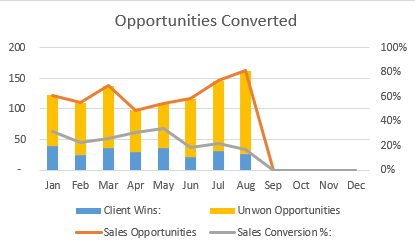
Monthly & Quarterly Board Numbers
In addition to your Strategic Financial Dashboard, you do have a responsibility to track some general business financials.
I prefer to present these to my clients each month in a visual format – ideally through a Real Time dashboard (like Power BI), but in a business your size using Xero and Fathom to present:
- Revenue
- Gross Profit Margin
- Break Even Point
- Net or Operating Profit
- Cash Flow
- Growth Efficiency
- Profit & Loss Financials versus previous Periods, previous Years, and against Budget (where a Budget makes sense for your business)
- Balance Sheet versus previous Periods and previous Years
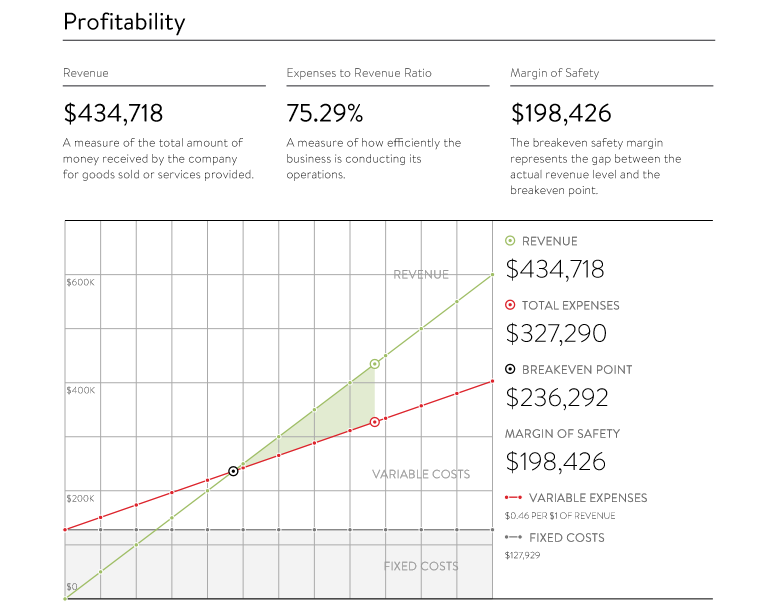
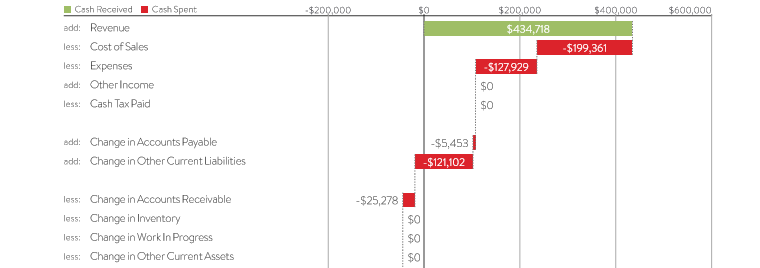
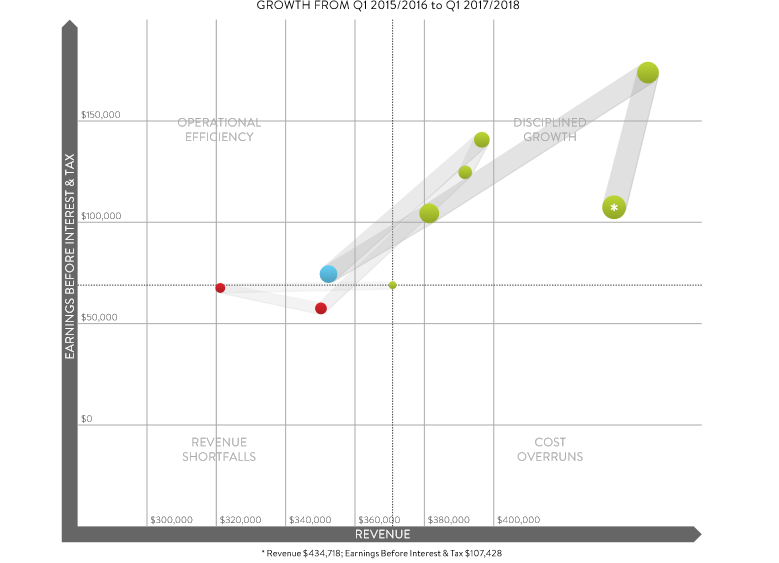

Depending on the structure of your business, I would also generally recommend some breakdown reports – such as revenue and profitability by Product / Market / Team.
7. Priorities Dashboard
This type of Dashboard goes by many different names in different systems, from the Rockefeller Habits to the BGI ‘Business on a Page’ to the EOS ‘Entrepreneurs Operating System’. So you may have heard about “Big Rocks” and “Quarterly Objectives” before.
Don’t let the jargon fool you – this is a simple list of What Tasks are going to be completed by Whom during this Quarter.
(And we only look at the current Quarter. The only two timeframes that matter in business are 20 Years, which is your Vision, and 90 Days which is here. Try not to set ‘Annual’ tasks, as it’s far too easy for these to only become a priority in the weeks leading up to next year’s Strategy Day.)
At your Annual Strategy Day or the subsequent Board Meeting or Strategy Session, these tasks are defined as a simple, agreed To Do List. You may choose to monitor them weekly or monthly, if you have more frequent operations meetings.
Hopefully you and your team can be trusted to achieve what they promise each Month, and come to the next Monthly Meetings ready for the next specific tasks to address whatever Issues or Opportunities arise.
As with the Financial Scorecard, if you have nothing already in place then a central tool like Google Sheets or Excel Online can quickly be set up to track these Tasks and progress. Any Workflow or Project Management software you already use will be more efficient and effective.
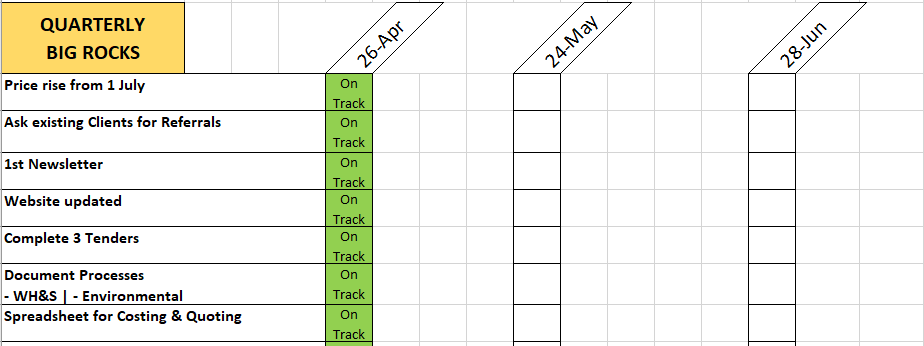
How can Jacob Aldridge Help?
Congratulations on making it to the end of this Complete How To Guide for Business Strategy. You now have clear Business Plan templates, agendas, guides, and examples to connect your Vision through Strategy to your weekly and daily business operations.
Are you ready to do it all yourself? If not … I can help.
You are a Capability Phase business with 35-120 Employees. When I review the clients I have helped to deliver the greatest return on strategic investment, almost all of them sit within this range. I can help your business in 3 Ways:
1. Annual Strategy Day Facilitation
Not sure where to go next with your Strategic Planning, or want to start at the beginning? Let me help you prepare and facilitate your first (or next) Annual Strategy Day.
This includes meeting with all business owners beforehand to tailor your agenda, attendee list, and desired outcomes; plus the follow-up meeting 2-4 weeks later where we ensure the Strategy is brought back into the business.
Some business owners and CEOs feel that their business is not ready for the amorphous reality of a Strategy Day – that perhaps some additional guidance may be required first. In that case I would conduct a Strategic Business Review with you, your business partners, and your team – culminating in a guided half day strategy workshop or a full Strategy Day.
At every stage, my team will provide you with supporting documentation, diagrams, and language to assist.
Outcomes of your Facilitation or Business Review
At the conclusion of your Strategy Day or Business Review, you will have a fuller understanding of your business today and a narrow focus of the 2 or 3 strategic priorities you can best focus on.
Of the 7 Elements of a Business Strategy System for a Capability Phase business you will have achieved:
- Documented Vision
- Annual Strategy Day
- Capacity Roadmap Plan (High Level)
Your Investment
On average, my clients simply implementing the system I have outlined in this guide achieve a 20% increase in revenue. For a Process Phase business that looks like a $300,000+ annual increase to your turnover.
Annual Strategy Day facilitation, including preparation and follow-up expertise, is $4,000 (+tax +travel and accommodation where applicable).

My team and I will conduct a Business Review with you and your team, in person or anywhere in the world, from $7,500 (+tax where applicable).
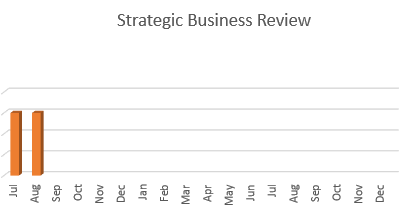
When was the last time you had your business confidentially reviewed by an objective, expert advisor? Contact Jacob to start the conversation now.
2. Implementing this Entire Strategic Planning System with you
As a Capability Phase business owner and CEO, you know that being responsible for implementing any new system (even one as valuable as better strategy and better strategic capability) is not the best use of your valuable time.
But you can definitely see the value in an expert who can help you implement this impressive business strategy system.
In this option, I will deliver you:
4. Monthly Board Meeting
including Monthly Financial Reports (Xero Advisor Access required)
5. Monthly Strategy Session
General at first, and with the option to evolve into specific project advisory work while the general sessions continue
6. Weekly Financial Scorecard
7. Priorities Dashboard
As you can see, this connects with a Business Review (above) or is ideal for business owners with existing Business Plans seeking help executing on their ideas.
Your Investment
All of this from just $3,500+tax per month.
In my world, relationships are free. If you can see the value of this option, let’s chat to ensure you invest to receive everything you want and nothing you don’t need.
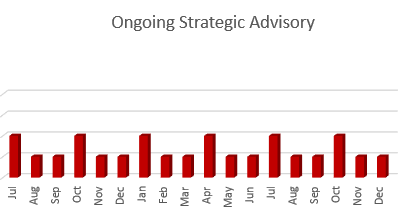
3. Bespoke Strategic Advisory
Options 1 and 2 are great for helping you implement a strategy system you can run by yourself (or with intermittent guidance) for the life of your business.
But if you want fast growth, tailored outcomes, or a relationship that’s more like a business partner than an external coach, bespoke strategic advisory services are for you.
Being ‘Bespoke’, there are myriad ways this could work – so let’s chat.
The most common formats are outlined on my “How much does business coaching cost?” page:
- CEO or Partner 1-on-1 Coaching for 1-3 Partners, from $1,000+tax per month
- Tailored Strategic Projects, designing your detailed strategy and implementation plans from $12,770+tax (spread over several months)
- Retire Young, Retire Rich, Never Retire – where you can leverage my global team to achieve any business vision you desire. Services from $63,770 + Mutually agreed Success Fee and timetable to balance your cash flow and need for speed
- Group Programs, if your Process Phase business is part of a larger network or you have the opportunity to Franchise or License your business for accelerated growth.
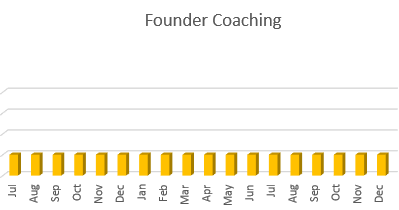
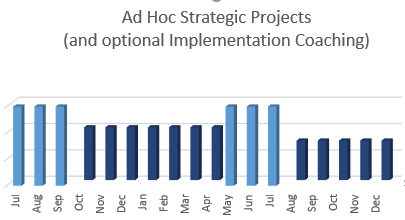
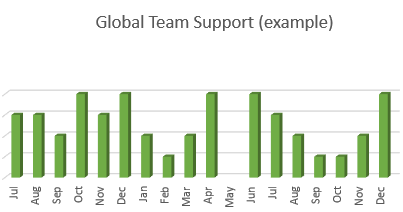
If you are considering an investment in an experience strategic business advisor, with specific experience helping businesses at your size, then my Shameless Praise review page may also be of interest to you.
In Conclusion
If you plan to do it yourself, I hope you find this ‘Complete How To Guide to Strategic Business Planning’ covers your every question. If not – use the Comments below to help me fill the gaps for you, and others.
If you’ve suddenly realised, maybe for the first time, how much potential your business has and how much faster you could achieve that with an experienced guide by your side – then I look forward to meeting with you soon.






[…] I have 12-35 Staff | I have 35-120 Staff | I have 120-500 […]
[…] I have 2-12 Staff | I have 35-120 Staff | I have 120-500 […]
[…] can grow quite rapidly through this phase, from $5 million to $17 million in gross profit, as long as they are willing to reinvent all the processes that helped them to the starting line. […]